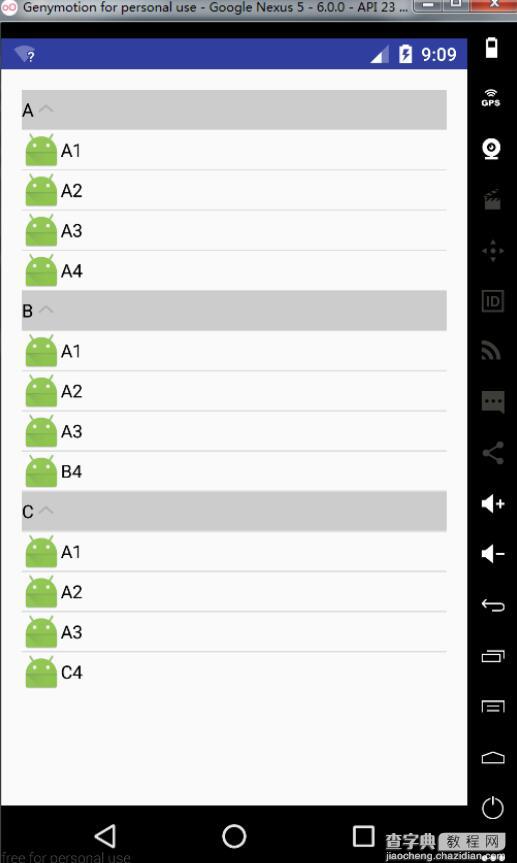ExpandableListView介绍
ExpandableListView的引入
ExpandableListView可以显示一个视图垂直滚动显示两级列表中的条目,这不同于列表视图(ListView)。ExpandableListView允许有两个层次:一级列表中有二级列表。
比如在手机设置中,对于分类,有很好的效果。手机版QQ也是这样的效果。

使用ExpandableListView的整体思路
(1)给ExpandableListView设置适配器,那么必须先设置数据源。
(2)数据源,就是此处的适配器类ExpandableAdapter,此方法继承了BaseExpandableListAdapter,需要重写里面的10个方法。
数据源中,用到了自定义的View布局,此时根据自己的需求,来设置组和子项的布局样式。
getChildView()和getGroupView()方法设置自定义布局。
(3)数据源设置好,直接给ExpandableListView.setAdapter()即可实现此收缩功能。
ExpandableListView的完整代码实现
(1)activity_main.xml:在里面放置一个ExpandableListView控件
<"1.0" encoding="utf-8"?> <RelativeLayout xmlns:android="http://schemas.android.com/apk/res/android" xmlns:tools="http://schemas.android.com/tools" android:layout_width="match_parent" android:layout_height="match_parent" android:paddingBottom="@dimen/activity_vertical_margin" android:paddingLeft="@dimen/activity_horizontal_margin" android:paddingRight="@dimen/activity_horizontal_margin" android:paddingTop="@dimen/activity_vertical_margin" tools:context="com.smyhvae.expandablelistviewdemo.MainActivity"> <ExpandableListView android:id="@+id/expandableListView" android:layout_width="match_parent" android:layout_height="wrap_content" /> </RelativeLayout>
(2)item_group.xml:一级列表的item的布局
<"1.0" encoding="utf-8"?> <LinearLayout xmlns:android="http://schemas.android.com/apk/res/android" android:layout_width="match_parent" android:layout_height="wrap_content" android:background="#cccccc" android:orientation="horizontal"> <TextView android:id="@+id/tv_group" android:layout_width="wrap_content" android:layout_height="30dp" android:gravity="center" android:text="group text" android:textColor="#000000" /> </LinearLayout>
(3)item_child.xml:二级列表的item的布局
<"1.0" encoding="utf-8"?> <LinearLayout xmlns:android="http://schemas.android.com/apk/res/android" android:layout_width="match_parent" android:layout_height="wrap_content" android:gravity="center" android:orientation="horizontal"> <ImageView android:id="@+id/iv_child" android:layout_width="30dp" android:layout_height="30dp" android:src="@mipmap/ic_launcher"/> <TextView android:id="@+id/tv_child" android:layout_width="match_parent" android:layout_height="wrap_content" android:text="item text" android:textColor="#000000"/> </LinearLayout>
(4)MainActivity.java:
import android.app.Activity; import android.os.Bundle; import android.util.Log; import android.view.View; import android.view.ViewGroup; import android.widget.BaseExpandableListAdapter; import android.widget.ExpandableListView; import android.widget.ImageView; import android.widget.TextView; public class MainActivity extends Activity { //View private ExpandableListView expandableListView; //Model:定义的数据 private String[] groups = {"A", "B", "C"}; //注意,字符数组不要写成{{"A1,A2,A3,A4"}, {"B1,B2,B3,B4,B5"}, {"C1,C2,C3,C4"}} private String[][] childs = {{"A1", "A2", "A3", "A4"}, {"A1", "A2", "A3", "B4"}, {"A1", "A2", "A3", "C4"}}; @Override protected void onCreate(Bundle savedInstanceState) { super.onCreate(savedInstanceState); setContentView(R.layout.activity_main); expandableListView = (ExpandableListView) findViewById(R.id.expandableListView); expandableListView.setAdapter(new MyExpandableListView()); } //为ExpandableListView自定义适配器 class MyExpandableListView extends BaseExpandableListAdapter { //返回一级列表的个数 @Override public int getGroupCount() { return groups.length; } //返回每个二级列表的个数 @Override public int getChildrenCount(int groupPosition) { //参数groupPosition表示第几个一级列表 Log.d("smyhvae", "-->" + groupPosition); return childs[groupPosition].length; } //返回一级列表的单个item(返回的是对象) @Override public Object getGroup(int groupPosition) { return groups[groupPosition]; } //返回二级列表中的单个item(返回的是对象) @Override public Object getChild(int groupPosition, int childPosition) { return childs[groupPosition][childPosition]; //不要误写成groups[groupPosition][childPosition] } @Override public long getGroupId(int groupPosition) { return groupPosition; } @Override public long getChildId(int groupPosition, int childPosition) { return childPosition; } //每个item的id是否是固定?一般为true @Override public boolean hasStableIds() { return true; } //【重要】填充一级列表 @Override public View getGroupView(int groupPosition, boolean isExpanded, View convertView, ViewGroup parent) { if (convertView == null) { convertView = getLayoutInflater().inflate(R.layout.item_group, null); } else { } TextView tv_group = (TextView) convertView.findViewById(R.id.tv_group); tv_group.setText(groups[groupPosition]); return convertView; } //【重要】填充二级列表 @Override public View getChildView(int groupPosition, int childPosition, boolean isLastChild, View convertView, ViewGroup parent) { if (convertView == null) { convertView = getLayoutInflater().inflate(R.layout.item_child, null); } ImageView iv_child = (ImageView) convertView.findViewById(R.id.iv_child); TextView tv_child = (TextView) convertView.findViewById(R.id.tv_child); //iv_child.setImageResource(resId); tv_child.setText(childs[groupPosition][childPosition]); return convertView; } //二级列表中的item是否能够被选中?可以改为true @Override public boolean isChildSelectable(int groupPosition, int childPosition) { return true; } } }
注:请自行完成ConvertView和ViewHolder的优化。
工程文件:(Android Studio 2.1)http://xiazai.jb51.net/201609/yuanma/AndroidExpandableListView(jb51.net).rar
以上就是本文的全部内容,希望对大家的学习有所帮助,也希望大家多多支持查字典教程网。
【Android UI控件ExpandableListView基本用法详解】相关文章:
★ Android自定义Adapter的ListView的思路及代码
★ Android之PreferenceActivity应用详解
★ Android TextView和ImageView简单说明
★ Android 动画之ScaleAnimation应用详解
★ Android笔记之:在ScrollView中嵌套ListView的方法
★ Android 动画之TranslateAnimation应用详解
